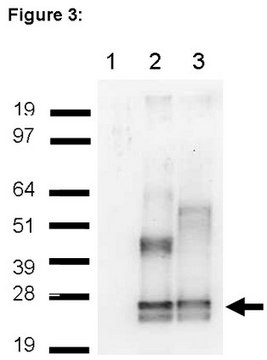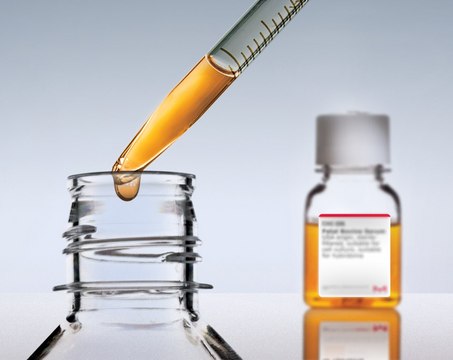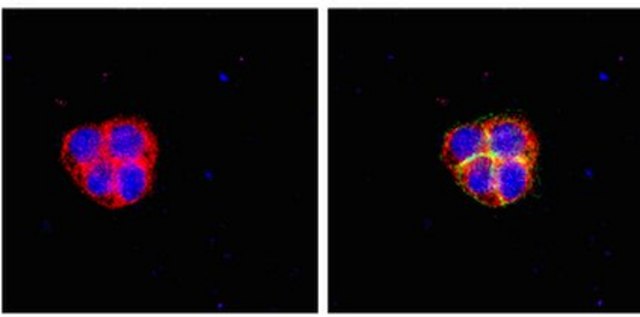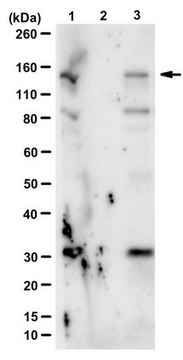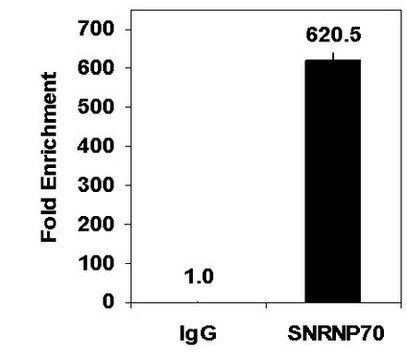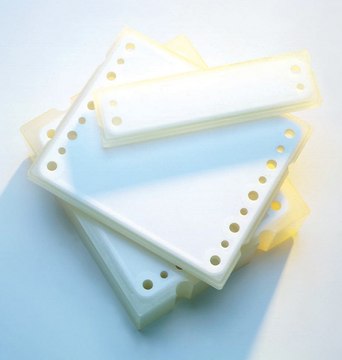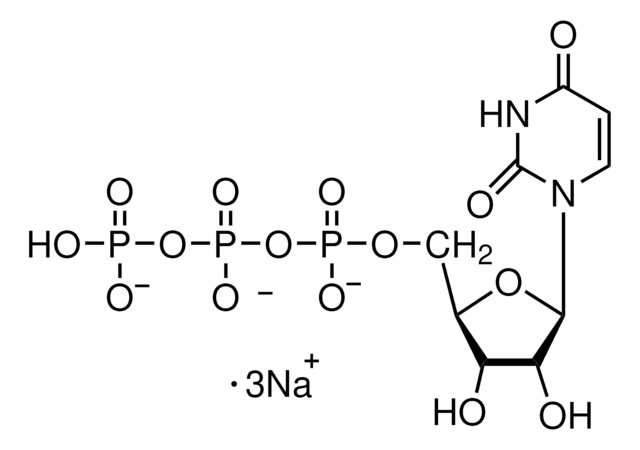03-191
RIPAb+ Upf1 - RIP Validated Antibody and Primer Set
from rabbit
Sign Into View Organizational & Contract Pricing
All Photos(3)
Synonym(s):
ATP-dependent helicase RENT1, Nonsense mRNA reducing factor 1, UP Frameshift 1, UPF1 regulator of nonsense transcripts homolog (yeast), Up-frameshift suppressor 1 homolog, delta helicase, regulator of nonsense transcripts 1, up-frameshift mutation 1 homo
UNSPSC Code:
12352203
eCl@ss:
32160702
NACRES:
NA.32
Recommended Products
biological source
rabbit
Quality Level
clone
polyclonal
species reactivity
human
species reactivity (predicted by homology)
mouse, bovine, canine, rat
manufacturer/tradename
RIPAb+
Upstate®
technique(s)
RIP: suitable
immunoprecipitation (IP): suitable
western blot: suitable
NCBI accession no.
UniProt accession no.
shipped in
dry ice
General description
Upf1 is part of a post-splicing multiprotein complex involved in both mRNA nuclear export and mRNA surveillance. mRNA surveillance detects exported mRNAs with truncated open reading frames and initiates nonsense-mediated mRNA decay (NMD). When translation ends upstream from the last exon-exon junction, this triggers NMD to degrade mRNAs containing premature stop codons. Upf1 is located only in the cytoplasm. When translation ends, it interacts with the protein that is a functional homolog of yeast Upf2p to trigger mRNA decapping.
Specificity
This antibody detects Upf1.
Immunogen
KLH-conjugated synthetic linear peptide corresponding to Upf1.
Application
Immunoprecipitation from RIP lysate:
Representative lot data.
RIP lysate from HeLa cells (~2 X 10E7 cell equivalents per IP) was subjected to immunoprecipitation using either 7 µL of a normal rabbit IgG or 7 µL of Anti-Upf1 antibody.
Ten percent of the precipitated proteins (lane 1: rabbit IgG, lane 2: Upf1) were resolved by electrophoresis, transferred to PVDF and probed with anti-Upf1 antibody (1:2000).
Proteins were visualized using One-Step IP-Western kit (GenScript Cat. # L00232)
Arrow indicates Upf1 (~125 kDa) (Please see figures).
Western Blot Analysis:
Representative lot data.
U2OS cell lysate was resolved by electrophoresis, transferred to PVDF membrane and probed with anti-Upf1 (0.5 μg/mL).
Proteins were visualized using a donkey anti-rabbit secondary antibody conjugated to HRP and a chemiluminescence detection system.
Arrow indicates Upf1 (~125 kDa) (Please see figures).
Representative lot data.
RIP lysate from HeLa cells (~2 X 10E7 cell equivalents per IP) was subjected to immunoprecipitation using either 7 µL of a normal rabbit IgG or 7 µL of Anti-Upf1 antibody.
Ten percent of the precipitated proteins (lane 1: rabbit IgG, lane 2: Upf1) were resolved by electrophoresis, transferred to PVDF and probed with anti-Upf1 antibody (1:2000).
Proteins were visualized using One-Step IP-Western kit (GenScript Cat. # L00232)
Arrow indicates Upf1 (~125 kDa) (Please see figures).
Western Blot Analysis:
Representative lot data.
U2OS cell lysate was resolved by electrophoresis, transferred to PVDF membrane and probed with anti-Upf1 (0.5 μg/mL).
Proteins were visualized using a donkey anti-rabbit secondary antibody conjugated to HRP and a chemiluminescence detection system.
Arrow indicates Upf1 (~125 kDa) (Please see figures).
Research Category
Epigenetics & Nuclear Function
Epigenetics & Nuclear Function
Research Sub Category
RNA Binding Protein (RBP)
RNA Binding Protein (RBP)
This RIPAb+ Upf1 -RIP Validated Antibody & Primer Set conveniently includes the antibody & the specific control PCR primers.
Packaging
10 assays per set. Recommended use: ~7 μL of antibody per RIP (dependent upon biological context).
Quality
RNA Binding Protein Immunoprecipitation:
RIP Lysate prepared from HeLa cells (2 X 10E7 cell equivalents per IP) were subjected to immunoprecipitation using either 7 µL of a normal rabbit IgG or 7 µL Anti-Upf1 antibody and the Magna RIP® RNA-Binding Protein Immunoprecipitation Kit (Cat. # 17-700).
Successful immunoprecipitation of Upf1-associated RNA was verified by qPCR using RIP Primers ARF1 (Please see figures).
Please refer to the Magna RIP (Cat. # 17-700) or EZ-Magna RIP (Cat. # 17-701) protocol for experimental details.
RIP Lysate prepared from HeLa cells (2 X 10E7 cell equivalents per IP) were subjected to immunoprecipitation using either 7 µL of a normal rabbit IgG or 7 µL Anti-Upf1 antibody and the Magna RIP® RNA-Binding Protein Immunoprecipitation Kit (Cat. # 17-700).
Successful immunoprecipitation of Upf1-associated RNA was verified by qPCR using RIP Primers ARF1 (Please see figures).
Please refer to the Magna RIP (Cat. # 17-700) or EZ-Magna RIP (Cat. # 17-701) protocol for experimental details.
Target description
~125 kDa
Physical form
Affinity purified
Anti-Upf1 (Rabbit Polyclonal). One vial containing 70 μL of purified rabbit polyclonal antibody in buffer containing 0.1 M Tris-Glycine (pH 7.4), 150 mM NaCl with 0.05% sodium azide and 30% glycerol. Store at -20°C.
Normal Rabbit IgG. One vial containing 125 µg of rabbit IgG in 125 µL of storage buffer containing 0.05% sodium azide. Store at -20°C.
RIP Primers, ARF1. One vial containing 75 μL of 5 μM of each primer specific for human ARF1.
Store at -20°C.
FOR: GAC CAC GAT CCT CTA CAA GC
REV: TCC CAC ACA GTG AAG CTG ATG
Normal Rabbit IgG. One vial containing 125 µg of rabbit IgG in 125 µL of storage buffer containing 0.05% sodium azide. Store at -20°C.
RIP Primers, ARF1. One vial containing 75 μL of 5 μM of each primer specific for human ARF1.
Store at -20°C.
FOR: GAC CAC GAT CCT CTA CAA GC
REV: TCC CAC ACA GTG AAG CTG ATG
Format: Purified
Storage and Stability
Stable for 1 year at -20°C from date of receipt.
Handling Recommendations: Upon receipt, and prior to removing the cap, centrifuge the vial and gently mix the solution. Aliquot into microcentrifuge tubes and store at -20°C. Avoid repeated freeze/thaw cycles, which may damage IgG and affect product performance. Note: Variability in freezer temperatures below -20°C may cause glycerol containing solutions to become frozen during storage.
Handling Recommendations: Upon receipt, and prior to removing the cap, centrifuge the vial and gently mix the solution. Aliquot into microcentrifuge tubes and store at -20°C. Avoid repeated freeze/thaw cycles, which may damage IgG and affect product performance. Note: Variability in freezer temperatures below -20°C may cause glycerol containing solutions to become frozen during storage.
Analysis Note
Control
Includes negative control normal rabbit IgG antibody and control primers specific for the cDNA of human ARF1.
Includes negative control normal rabbit IgG antibody and control primers specific for the cDNA of human ARF1.
Legal Information
MAGNA RIP is a registered trademark of Merck KGaA, Darmstadt, Germany
UPSTATE is a registered trademark of Merck KGaA, Darmstadt, Germany
Disclaimer
Unless otherwise stated in our catalog or other company documentation accompanying the product(s), our products are intended for research use only and are not to be used for any other purpose, which includes but is not limited to, unauthorized commercial uses, in vitro diagnostic uses, ex vivo or in vivo therapeutic uses or any type of consumption or application to humans or animals.
WGK
WGK 2
Certificates of Analysis (COA)
Search for Certificates of Analysis (COA) by entering the products Lot/Batch Number. Lot and Batch Numbers can be found on a product’s label following the words ‘Lot’ or ‘Batch’.
Already Own This Product?
Find documentation for the products that you have recently purchased in the Document Library.
Rik Mencke et al.
JCI insight, 2(20) (2017-10-20)
Klotho is a renal protein involved in phosphate homeostasis, which is downregulated in renal disease. It has long been considered an antiaging factor. Two Klotho gene transcripts are thought to encode membrane-bound and secreted Klotho. Indeed, soluble Klotho is detectable
Human nonsense-mediated RNA decay initiates widely by endonucleolysis and targets snoRNA host genes.
Søren Lykke-Andersen et al.
Genes & development, 28(22), 2498-2517 (2014-11-19)
Eukaryotic RNAs with premature termination codons (PTCs) are eliminated by nonsense-mediated decay (NMD). While human nonsense RNA degradation can be initiated either by an endonucleolytic cleavage event near the PTC or through decapping, the individual contribution of these activities on
Our team of scientists has experience in all areas of research including Life Science, Material Science, Chemical Synthesis, Chromatography, Analytical and many others.
Contact Technical Service